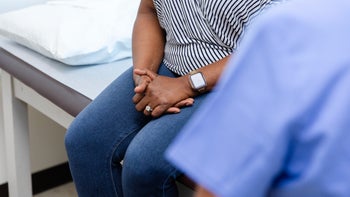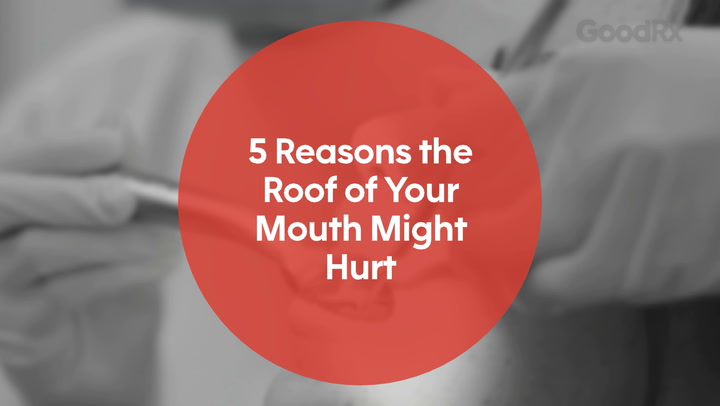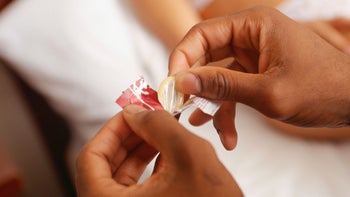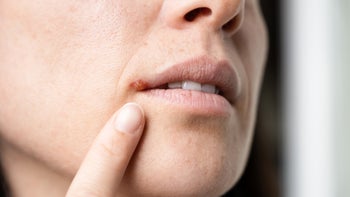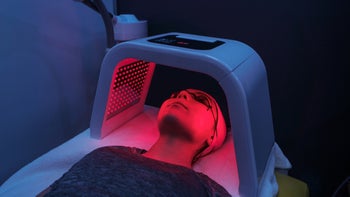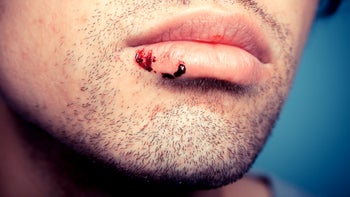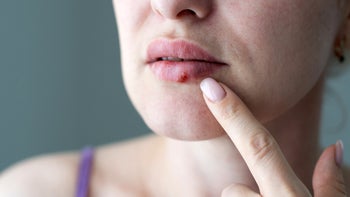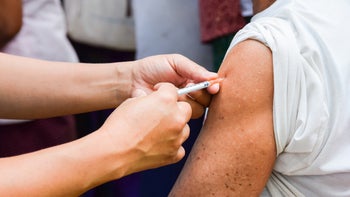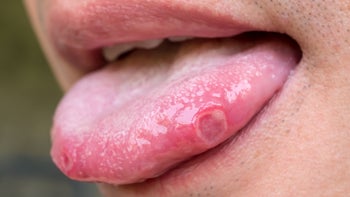
Symptoms of Genital Herpes: 8 Common Signs to Look for
Key takeaways:
Genital herpes is a common sexually transmitted infection (STI) that leads to genital irritation and sores.
Many cases of genital herpes can be mild, or symptoms can be vague. So, some people may not even realize they have it.
Someone without symptoms can pass genital herpes to a sexual partner. It’s important for people who are sexually active to get regular testing to know if they have the virus.
Table of contents

Genital herpes is a sexually transmitted infection (STI) that’s much more common than most people realize. About 1 in 5 people in the U.S. have genital herpes, although the actual number is likely higher, since many people don’t know they have it.
Genital herpes is caused by a virus (herpes simplex virus, or HSV) that lives in the body forever. And it can easily spread from person to person during oral, genital, or anal sex — even when a person doesn’t have active symptoms.
Let’s take a closer look at eight common symptoms of genital herpes, so you’ll know what to look for and when to get tested.
Search and compare options
Symptoms of genital herpes
The symptoms of genital herpes may be vague and hard to pinpoint before the sores appear. Here are some of the signs to watch out for.
1. Fever or chills
A fever is your body’s response to a boost in the immune system to handle viruses, like herpes. At the same time, chills can happen as your body tries to control its temperature during a fever.
2. Headache
When your body fights a virus, like genital herpes, it can cause flu-like symptoms. And headaches are common with a herpes infection.
3. Fatigue
Fatigue is a common symptom of genital herpes as your body’s defenses kick into action. It’s more often seen as a symptom of your first outbreak, and it’s not as common with recurrent flares. You may feel tired because your body is putting a lot of energy into fighting the virus.
4. Aches and pains
The immune response to the herpes virus can cause inflammation and irritation. This occurs not only in the genital area but also throughout the body. And this can leave your body and muscles feeling achy. Again, you’re more likely to see this with your initial infection.
5. Visible sores
One of the most well-known signs of genital herpes is having sores or lesions on the genitals. These sores can be painful and look different for each person. These sores can include:
Blisters
Pimples
Open sores
Scabbing lesions
Have you wondered about the difference between oral and genital herpes? Read more about the two viruses that cause herpes.
HPV vs. HSV: Find out how these common infections differ from one another, and learn strategies for prevention and treatment.
Can you get herpes from kissing? Yes, you can get herpes from kissing. Learn more about all the ways herpes can be spread from one person to another.
6. Swollen genital lymph nodes
Swollen lymph nodes in the genital area are common with a herpes infection. Lymph nodes are normally pea-sized glands located throughout the body to help you fight infection. The glands in the groin might get bigger and feel sore during a genital herpes outbreak.
7. Tingling or itching around the groin or anus
Before the sores appear, there can be tingling or itching in the private area or around the bottom. This can also sometimes feel like a burning sensation. This can be a sign that a herpes outbreak is about to happen.
8. Burning with urination
Discomfort when you urinate can be a sign of a genital herpes infection. While herpes doesn’t directly impact the urinary tract, the open sores can become irritated and hurt when urine touches them.
Quiz: Do you have a UTI or a STD/STI?
What does a genital herpes outbreak look like?
The first outbreak of genital herpes, also known as the primary outbreak, tends to be the most severe. Usually, a red patch of skin shows up with tiny bumps that feel a bit raised. These bumps turn into clear, fluid-filled bumps called “vesicles.” Later, the bumps break open and become painful sores.
As the sores heal, they form scabs. It usually takes about 2 weeks for the scabs to go away, but sometimes it can take up to 6 weeks. During this time, you might feel itchy or uncomfortable. You may also notice some systemic symptoms, like fever, chills, or fatigue.
Taking good care of the sores and getting treatment can help them go away faster. But it’s important to know that herpes sores can come back again and again over time. Future outbreaks may be milder. Future outbreaks may have fewer sores, less-severe symptoms, and happen less often.
Can I have genital herpes and not know it?
It’s possible to have genital herpes and not know it. That’s because not everyone with genital herpes experiences noticeable symptoms.
There are two types of herpes: herpes simplex virus 1 (HSV-1) and herpes simplex virus 2 (HSV-2). HSV-2 more commonly causes genital herpes. HSV-1 usually causes oral herpes, but some cases of genital herpes are due to HSV-1. This may be the case if the virus is transmitted from the mouth to the genitals during oral sex.
Both types may cause no symptoms or only mild symptoms. Mild cases often go unnoticed. And a single sore can be confused with an ingrown hair, razor burn, or even just minor irritation.
If you think that you may have been exposed or infected, it’s important to know what to look out for. By knowing the signs and symptoms, you may be able to prevent transmission.
Active sores increase the risk of transmitting the infection. But it’s important to keep in mind that it’s still possible to pass the virus to your sexual partner(s) even if you don’t have any sores.
What other conditions can look like genital herpes?
There are several STIs that can cause bumps and sores that look a lot like genital herpes. But there are some helpful clues that may help you and your healthcare professional tell the difference:
Syphilis sores: Unlike herpes sores, which tend to cause some discomfort, syphilis sores aren’t painful.
Chancroid ulcers: These often appear more gray or yellow. And the fluid inside the bumps appears white (rather than clear).
Lymphogranuloma venereum: This generally causes painless bumps or ulcers, unlike the painful ulcers in herpes.
Granuloma inguinale ulcers: These are painless and tend to have a red, beefy appearance. They may bleed easily.
Genital herpes can also be mistaken for other conditions that aren’t transmitted sexually. This is especially true if someone doesn’t have the hallmark sores. Some common examples include:
Ingrown hairs, razor bumps, or pimples
Hemorrhoids (when the sores are around the anus)
Urinary tract infection (UTI)
Yeast infection, especially in women
Vaginitis (a condition that leads to inflammation of the vagina)
The good news is that when the diagnosis is unclear, there are some simple tests that can help.
Diagnosing genital herpes
If you do have active sores, a healthcare professional may swab the area and look at the sample under the microscope. They may also send the sample to a lab to test for the presence of HSV-1 and HSV-2.
You may also have a blood test if you don’t have active sores, but you’re worried about exposure. This can be helpful because it doesn’t need to be timed with an outbreak. Blood tests can have a few drawbacks, though:
Some blood tests can’t differentiate between HSV-1 and HSV-2.
If the test is positive, it doesn’t specify how long you’ve had the infection.
It isn’t always positive right after you get the infection. So, this may mean you need to schedule a repeat test.
Talk with a healthcare professional about the type of blood test that may be best for you. They can provide useful information, and you can do it at any time — even if you don’t have symptoms.
Treatment for genital herpes
There’s no cure for genital herpes, but there are effective medications that can treat an outbreak and help prevent future outbreaks. It’s important to get treatment as early as possible during your first outbreak, since your first HSV illness can be serious and prolonged. But treatment can lessen both symptom severity and length of illness.
The medications used to treat genital HSV infections block the virus from replicating (making more virus). Important oral medications used for treating HSV include:
Acyclovir (Zovirax)
Valacyclovir (Valtrex)
Famciclovir (Famvir)
If you have frequent outbreaks, a healthcare professional may prescribe a daily regimen as a suppressive therapy. (Suppressive therapy is when you take medication daily to decrease the frequency and severity of your outbreaks.)
If outbreaks are infrequent, you’ll probably only need to start medication at the first sign of an outbreak.
What to do if you think you may have genital herpes
If you’re worried that you may have genital herpes, don’t hesitate to reach out to a healthcare professional to schedule an appointment. If you have active sores, it’s possible to get a diagnosis of genital herpes based on appearance. But laboratory testing to confirm herpes infection is also available and recommended.
Frequently asked questions
Genital herpes can be very painful. The virus causes inflamed areas on the skin that blister, then rupture and scab over. The sores can feel itchy or burn. The sores can be particularly painful for women when urinating.
No, herpes can’t be cured. That’s because the virus is very good at hiding in the body. Researchers are trying to develop a vaccine to prevent herpes, but there isn’t one available at this time. Right now, the best treatment is to manage outbreaks with antiviral medications like Valtrex (valacyclovir) or Zovirax (acyclovir).
Your chance of getting herpes from an infected partner depends on the type of sex you engage in. Overall the risk is high because herpes is very contagious. In a heterosexual couple, the risk is between 3% to 10%, but your risk increases if:
The male partner is the one with herpes.
Your partner has active sores.
You don’t use a condom.
The uninfected partner is immunosuppressed.
Your infected partner isn’t being treated with an antiviral medication (like valacyclovir).
Herpes symptoms can start to appear anywhere from a few days to a few weeks after being exposed to the virus. You should get medical advice promptly if you may have been exposed to herpes or have symptoms. A healthcare professional can do tests to confirm the virus. They can also provide guidance on managing symptoms and preventing transmission.
The bottom line
Genital herpes can be a scary diagnosis for people who are sexually active. But it’s much more common than people realize. There are some common symptoms of herpes infection, but it’s possible to have the infection and not know it. If you’re sexually active, it’s always a good idea to get tested for a herpes infection and other sexually transmitted infections (STIs).
Why trust our experts?



References
American Academy of Dermatology Association. (n.d.). Genital herpes: Signs and symptoms.
American College of Obstetricians and Gynecologists. (2024). Genital herpes.
American Sexual Health Association. (n.d.). Diagnosing herpes.
American Sexual Health Association. (n.d.). Herpes signs and symptoms.
Arias-Santiago S., et al. (2010). Answer: Can you identify this condition? Canadian Family Physician.
Centers for Disease Control and Prevention. (2021). Sexually transmitted infections treatment guidelines 2021: Genital herpes.
Centers for Disease Control and Prevention. (2024). About genital herpes.
Institute for Quality and Efficiency in Health Care. (2025). Overview: Genital herpes. InformedHealth.org.
Irizarry, L., et al. (2023). Chancroid. StatPearls.
MedlinePlus. (2024). Genital herpes.
MedlinePlus. (2024). Genital herpes - self-care.
Rawla, P., et al. (2023). Lymphogranuloma venereum. StatPearls.
Santos-Júnior, C. D., et al. (2024). Discovery of antimicrobial peptides in the global microbiome with machine learning. Cell.
Tudor, M. E., et al. (2024). Syphilis. StatPearls.
World Health Organization. (2024). Over 1 in 5 adults worldwide has a genital herpes infection – WHO.
World Health Organization. (2025). Herpes simplex virus.


